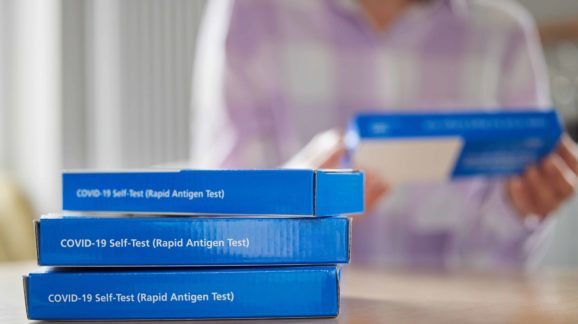Testing Our Patience
A few days ago, a large, plain manila envelope arrived at my home. It was unmarked except for a mailing label headlined “USPS Connect.” I didn’t remember ordering anything, and the Topeka, Kan., return address was unfamiliar.
I ripped open the envelope and out tumbled two Covid-19 rapid antigen tests but no explanatory materials. After a few seconds, it hit me. These were the tests I had ordered online from the government five weeks earlier after President Biden promised every American household could order up to four free at-home tests.
The tests’ arrival epitomized the Biden administration’s shambolic pandemic response. When Biden — who had promised in 2020 to “shut down the virus” — announced on December 21, 2021 that his administration would purchase and distribute 500 million rapid, at-home tests to Americans, it was already too little too late. And when my tests were delivered weeks later, cases of the Omicron variant — which had spread unabated throughout the vaccinated and unvaccinated populations — were already plummeting.
Omicron was first detected in South Africa in mid November 2021 and was designated a variant of concern by the World Health Organization on November 26. Multiple reports confirmed that Omicron was the most transmissible variant yet and appeared to escape vaccines’ protection against infection. The first U.S. case was identified on December 1.
By the time President Biden acknowledged the threat of Omicron and promised free at-home tests, the variant already accounted for over 70 percent of U.S. infections. Biden tried to excuse the scarcity of tests by claiming that no one could have anticipated the arrival and spread of Omicron or the need for testing.
But the rapidity of Omicron spread had been known for a month. And the U.S. had only recently finished the deadly Delta surge. The need for readily available, at-home tests had long been apparent. Yet the administration waited until late December to order tests that would not be delivered until months later.
I, with colleague Mario Loyola, wrote in March 2020 that developing readily available, antigen-based tests that could be self-administered at home and provide results in minutes, rather than the days needed for the standard polymerase chain reaction (PCR) tests, would enhance peoples’ ability to test and avoid endangering others. Biden’s CDC director Rochelle Walensky — then head of infectious diseases at the Massachusetts General Hospital — wrote in September 2020 that “rapid, saliva-based antigen testing is an essential weapon in the fight to resume many of the activities and reopen many of the venues that comprise what we used to call ‘normal life.’ It is practical, convenient, cost-effective, and easily scaled. . . . It is time to start asking why it is taking the FDA so long to approve this essential prevention technology.”
Yet the FDA continued to drag its feet in approving rapid at-home tests. Officials fretted that antigen tests might be slightly less accurate than PCR tests even though convenience and the ability to test repeatedly more than offset the risk of erroneous results. The tests remained far less available and more expensive than in Europe. And no one in the Biden administration exhibited any sense of urgency. The administration should have made large purchases of tests ahead of time, an approach that was so successful for vaccines under Operation Warp Speed, but it failed to do so.
Read the full article at National Review.
